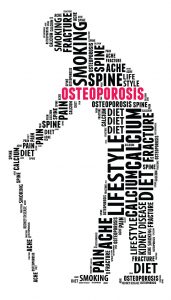Osteoporosis is a common condition which weakens bones, leaving them susceptible to fracture. The condition is most common amongst the older population, (especially women) and is slightly more prevalent among Caucasian and Asian populations, especially those of a light build.
Millions more have low bone mass (osteopenia), a pre-cursor to osteoporosis – early intervention could be the key to preventing the development of osteoporosis. Osteoporosis itself is a major health threat because of the increased risk of fracture, and the increased difficulty in healing if a fracture does occur – but don’t worry, there’s lots you can do!
The Dangers of Osteoporosis Drugs
Today, drugs are the go to option for osteoporosis treatment and prevention, and the common wisdom holds that this approach is safe and effective. As is so often the case however, this isn’t quite true!
In fact, the US Food and Drug Administration (FDA) recently issued an advisory warning about some osteoporosis meciations, specifically those known as Bisphosphonates – these include such drugs as Actonel, Boniva, Fosamax, Reclast and Zometa. As time has gone on, these medications have been shown to cause potentially severe joint pain in some patients – Worse, the use of bisphosphonates has also been linked to osteonecrosis of the jaw, more commonly known as ··”dead jaw.” Osteonecrosis occurs when part of the jawbone essentially dies and becomes exposed.
One drug in particular seems to be the most problematic – one study showed that long-term use of Fosamax is strongly associated with unusual fractures of the thigh bone[1], while another 2008 study found that Fosamax appears to double a woman ‘s odds of developing atrial fibrillation.[2]
As usual, the drug companies choose to downplay the risks of these medications, and have often been caught exaggerating the benefits Disturbingly, the drug companies not only downplay the risks of these medications, but they also exaggerate the benefits and are now often advocating prescribing these medications to individuals who show signs of low bone density, but not full osteoporosis. A recent report in the British medical journal showed that in fact, the risk of fracture among women with osteopenia is so low that these drugs would provide almost no benefit – but would provide dangerous side effects[3].
Preventing Osteoporosis Naturally
In some cases, medication might be necessary in some degree, but as usual, we encourage you first to consider the lengthy list of natural approaches which you can adopt with no risk of side effects! Lets look at a few:
Get Regular Chiropractic Check-ups
Regular exercise (especially weight bearing exercise) is essential to keeping bones healthy and strong. Chiropractic supports the body in working optimally, to allow you to exercise safely and without the fear of exaggerating any existing issues. Especially true in older individuals, chiropractic care can also help to correct postural imbalances, which might make resistance training uncomfortable, or a higher risk for injury.
In addition, Chiropractic care helps to preserve and maximize range of motion in the joints. [4]
Get Enough Calcium and Vitamin D
Calcium and vitamin D are necessary to build, repair and safeguard bones. Adults need at least 1,000 milligrams of calcium and 200 JU o vitamin D per day. Calcium and vitamin D are easy and inexpensive to add to your existing diet if required, either from food sources or supplementation. What’s more the effect you can expect is considerable! – A recent study conducted in Australia found that daily calcium doses of more than 1 ,200 milligrams reduced fracture risk by 20 percent, compared to 6 percent for doses of less than 1,200 milligrams[5].
Good sources of calcium include low fat milk, yogurt and cheese; collard greens; kale; broccoli ; and almond s. A daily calcium supplement can also help you reach your 1 ,000 mg. To maximize the effectiveness of calcium, take it in conjunction with magnesium.
Nutritionists typically suggest a 2: I ratio of calcium to magnesium, most supplements adhere quite closely to this ratio, but do check before purchase! Some people manage to get all the vitamin D they need from sun exposure, but in the UK its often necessary to take it in supplement form, especially during the winter.
Exercise!
Exercise is a key factor in preventing the development of bone weakness and osteoperosis. In fact, it’s been shown that weight bearing and resistance exercises combined with calcium citrate supplementation over one year can actually go to improve bone density in postmenopausal women, not just arrest a decline.[6]
Exercise need not be highly strenuous to have a positive effect either. Research suggest that 30 minutes of mild impact activity, such as brisk walking, most days could be enough to be effective.
Its also true that exercise can also help prevent falls in order people, since it improves muscle strength and balance. Exercising on a vibrating platform in particular can be especially advantageous for reducing the risk of falls (and is quite good fun too!)
Bulk up on B Vitamins
Research reveals that B vitamins are also crucial to maintaining bone density[7]. Vitamin B6 is plentiful in foods like potatoes. bananas, beans and fortified cereals. Vitamin B 12 is found mainly in meat, fish and poultry – but can be supplemented in the case of vegetarians.
A cup of tea might help!..
One study has shown that tea drinking is associated with preservation of hip structure in elderly women – In the four-year study of 1,500 elderly (70 to 85 years old) women , non-tea drinkers lost 4% of their total hi p BMD (bone mi neral density); tea drinkers lost only 1.6%.[8]
..But Cola wont
Women especially should stay away from cola– not only do these kinds of drinks lead to weight gain and contribute to the development of diabetes in many cases, a recent study published in the American Journal of Clinical Nutrition concluded that ”intake of cola, but not of other carbonated soft drinks. is associated with low BMD in women[9]. One possible culprit is phosphoric acid in cola. The body tries to neutralize the phosphoric acid with calcium – so if there isn’t enough calcium available in the diet, the body might scavenge it from the bones.
Limit Chocolate
Sadly, frequent chocolate consumption is linked to weak bones . One study of 1,00 1 women aged 70 to 85 concluded that “Older women who consume chocolate daily had lower bone density and strength .” (Sorry!) [10]
Don’t drink too much… 
Although excessive alcohol is associated with poor bone health, a 2008 study suggested that one drink per day may actually make bones stronger. The report found that individuals who consumed approximately one drink a day had a lower risk of hip fracture, when compared to individuals who drunk heavily, or who did not drink at all. [11]
Don ‘t Smoke
It’s now well understood that smoking is hazardous to the body in all sorts of ways – so its no surprise that smoking is also linked to low bone density. Numerous studies over the last 20 years demonstrate that cigarette smoking decreases bone density, although exactly how smoking affects bones is still unclear.
Manage Depression
Research links depression with bone loss – more research will be needed to determine whether depression itself is a fact in bone loss, or weather the existence of depression predisposes patients to other factors (such as smoking or poor nutritional intake) which in turn are the cause of bone loss. – Either way, its important to seek help with depression! [12]
[1] N Eng l J M ed 2008 ;358: 1304-6
[2] Arch Int Med 2008;168:826-3 1
[3] BMJ 2008;336: 126-9
[4] J Manipulative Physiol Ther 2001 ;24:55.2-5
[5] Lancet 2007;370:657 -66
[6] Osteoporos Int 2003;14:637-43
[7] JClin Endocrinol Metab 2008;93:2206- 12
[8] Am J Clin Nutr 2007;86: 1243-7
[9] Am J Clin N utr 2006;84:936-42
[10] Am J Clin Nutr 2008;87: 175-80
[11] Am J Med 2008 ;121:406-18
[12] Arch intern Med 2007; 167:2329-36

